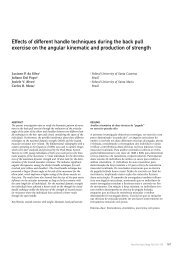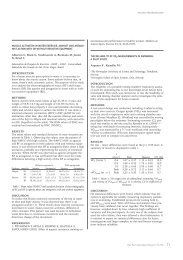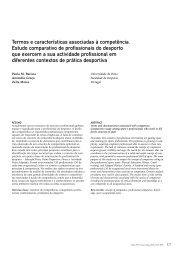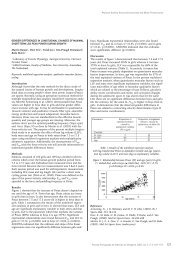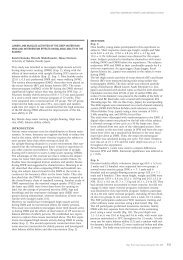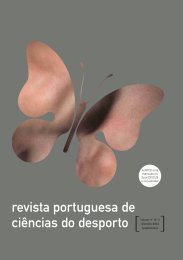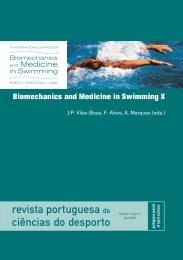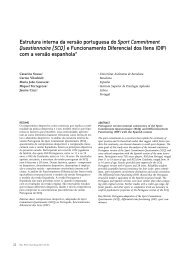35754-Revista FCDEF - Faculdade de Desporto da Universidade do ...
35754-Revista FCDEF - Faculdade de Desporto da Universidade do ...
35754-Revista FCDEF - Faculdade de Desporto da Universidade do ...
You also want an ePaper? Increase the reach of your titles
YUMPU automatically turns print PDFs into web optimized ePapers that Google loves.
<strong>de</strong>seja<strong>do</strong> e o manifesto, possibilita<strong>do</strong> pelo feedback negativo.<br />
Sen<strong>do</strong> assim, tanto a teoria <strong>de</strong> esquema como a abor<strong>da</strong>gem <strong>da</strong><br />
interferência contextual caracterizam-se como mo<strong>de</strong>los <strong>de</strong> equilíbrio,<br />
os quais são incapazes <strong>de</strong> explicar a aquisição <strong>de</strong> habili<strong>da</strong><strong>de</strong>s<br />
motoras além <strong>da</strong> estabilização, isto é, a aprendizagem<br />
motora como um processo contínuo em direção a esta<strong>do</strong>s crescentemente<br />
complexos <strong>de</strong> organização (Tani, 1982, 1995).<br />
Diante disso, nos últimos anos, o efeito <strong>da</strong> prática varia<strong>da</strong> na<br />
aquisição <strong>de</strong> habili<strong>da</strong><strong>de</strong>s motoras vem sen<strong>do</strong> investiga<strong>do</strong> sob<br />
um novo mo<strong>de</strong>lo teórico conheci<strong>do</strong> como <strong>de</strong> não-equilíbrio<br />
(Choshi & Tani, 1983; Tani, 1982). Esse mo<strong>de</strong>lo caracteriza o<br />
processo <strong>de</strong> aprendizagem motora como um ciclo contínuo <strong>de</strong><br />
instabili<strong>da</strong><strong>de</strong>-estabili<strong>da</strong><strong>de</strong>-instabili<strong>da</strong><strong>de</strong> em direção a complexi<strong>da</strong><strong>de</strong><br />
crescente, que se <strong>de</strong>senvolve mediante <strong>do</strong>is processos:<br />
estabilização e a<strong>da</strong>ptação. O processo <strong>de</strong> estabilização diz respeito<br />
à padronização espacial e temporal <strong>do</strong> movimento, ao<br />
passo que o processo <strong>de</strong> a<strong>da</strong>ptação refere-se à modificação e à<br />
reorganização <strong>da</strong>s habili<strong>da</strong><strong>de</strong>s já adquiri<strong>da</strong>s em novas habili<strong>da</strong><strong>de</strong>s.<br />
Dessa forma, os fatores que afetam a aquisição <strong>de</strong> habili<strong>da</strong><strong>de</strong>s<br />
motoras necessitam ser reestu<strong>da</strong><strong>do</strong>s à luz <strong>de</strong>ssa nova<br />
visão <strong>de</strong> aprendizagem motora.<br />
Dentro <strong>de</strong>ssa perspectiva, os estu<strong>do</strong>s sobre a estrutura <strong>da</strong> prática<br />
têm focaliza<strong>do</strong> os efeitos <strong>da</strong>s práticas constante, aleatória,<br />
contante-aleatória e aleatória-constante no processo <strong>de</strong> aquisição<br />
<strong>de</strong> habili<strong>da</strong><strong>de</strong>s motoras (Corrêa, 2001; Corrêa, Ben<strong>da</strong> &<br />
Tani, 2001; Corrêa, Ben<strong>da</strong>, Meira Júnior & Tani, 2003), e os<br />
seus acha<strong>do</strong>s têm aponta<strong>do</strong> para a superiori<strong>da</strong><strong>de</strong> <strong>da</strong> prática<br />
constante e constante-aleatória em relação às <strong>de</strong>mais. Em<br />
outras palavras, as evidências apontam para a necessi<strong>da</strong><strong>de</strong> <strong>da</strong><br />
prática constante anteriormente à prática aleatória no processo<br />
<strong>de</strong> aquisição <strong>de</strong> habili<strong>da</strong><strong>de</strong>s motoras. Esses resulta<strong>do</strong>s são contrários<br />
às proposições <strong>da</strong> teoria <strong>de</strong> esquema (Schmidt, 1975) e<br />
<strong>da</strong> abor<strong>da</strong>gem <strong>de</strong> interferência contextual (Battig, 1979), necessitan<strong>do</strong>,<br />
portanto, <strong>de</strong> outras explicações.<br />
Summers (1989) e Lai, Shea, Wulf & Wright (2000) têm feito<br />
algumas sugestões sobre a necessi<strong>da</strong><strong>de</strong> <strong>da</strong> prática constante<br />
anteriormente a prática varia<strong>da</strong> no processo <strong>de</strong> aquisição <strong>de</strong><br />
habili<strong>da</strong><strong>de</strong>s motoras. Especificamente, esses autores têm sugeri<strong>do</strong><br />
que a prática constante possibilitaria a formação <strong>do</strong> programa<br />
motor generaliza<strong>do</strong> e que a prática aleatória facilitaria a<br />
aprendizagem <strong>do</strong>s parâmetros. Entretanto, esses tipos <strong>de</strong> prática<br />
foram propostos <strong>de</strong>ntro <strong>de</strong> um mo<strong>de</strong>lo <strong>de</strong> equilíbrio, focalizan<strong>do</strong><br />
a aquisição <strong>de</strong> habili<strong>da</strong><strong>de</strong>s apenas como um processo <strong>de</strong><br />
estabilização.<br />
No que se refere ao processo a<strong>da</strong>ptativo, a superiori<strong>da</strong><strong>de</strong> <strong>da</strong> prática<br />
constante segui<strong>da</strong> <strong>de</strong> varia<strong>da</strong> tem si<strong>do</strong> atribuí<strong>da</strong> ao fato <strong>da</strong><br />
prática constante facilitar a formação <strong>de</strong> padrão - uma estrutura<br />
a partir <strong>da</strong> interação entre os componentes <strong>da</strong> habili<strong>da</strong><strong>de</strong> - e a<br />
prática varia<strong>da</strong> possibilitar a diversificação <strong>de</strong>sse padrão mediante<br />
a variação nos componentes. Como resulta<strong>do</strong>, o padrão ou<br />
programa <strong>de</strong> ação adquire uma estrutura hierarquicamente<br />
organiza<strong>da</strong> em <strong>do</strong>is níveis: uma macroestrutura, orienta<strong>da</strong> à<br />
or<strong>de</strong>m e responsável pela consistência <strong>da</strong> habili<strong>da</strong><strong>de</strong> e uma<br />
microestrutura, orienta<strong>da</strong> à <strong>de</strong>sor<strong>de</strong>m e responsável pela sua flexibili<strong>da</strong><strong>de</strong><br />
(Tani, 1982, 1995; Manoel & Connolly, 1995, 1997).<br />
Referências bibliográficas<br />
BATTIG, W.F. (1979). The flexibility of human memory. In L.S.<br />
Cermak & F.I.M. Craik (Eds.), Levels of processing in human<br />
memory. Hills<strong>da</strong>le, New Jersey: Lawrence Erlbaum.<br />
CHOSHI, K. & TANI, G. (1983). Stable system and a<strong>da</strong>ptive<br />
system in motor learning. In Japanese Association of<br />
Biomechanics (Ed.), The science of movement V. Tokyo: Kyorin<br />
(in Japanese).<br />
CORRÊA, U.C. (2001). Estrutura <strong>de</strong> prática e processo a<strong>da</strong>ptativo<br />
na aquisição <strong>de</strong> habili<strong>da</strong><strong>de</strong>s motoras. Tese <strong>de</strong> Doutora<strong>do</strong>.<br />
São Paulo: Escola <strong>de</strong> Educação Física e Esporte <strong>da</strong><br />
Universi<strong>da</strong><strong>de</strong> <strong>de</strong> São Paulo.<br />
CORRÊA, U.C.; BENDA, R.N.; MEIRA JUNIOR, C.M. &<br />
TANI, G. (2003). Practice schedule and a<strong>da</strong>ptive process in<br />
the acquisition of a manual force control task. Journal of<br />
Human Movement Studies 44, 121-138.<br />
CORRÊA, U.C.; BENDA, R.N. & TANI, G. (2001). Estrutura<br />
<strong>de</strong> prática e processo a<strong>da</strong>ptativo na aprendizagem <strong>do</strong> arremesso<br />
<strong>de</strong> <strong>da</strong>r<strong>do</strong> <strong>de</strong> salão. <strong>Revista</strong> Brasileira <strong>de</strong> Ciências <strong>do</strong> Esporte 22,<br />
69-84.<br />
CORRÊA, U.C. & TANI, G. (no prelo). Estrutura <strong>de</strong> prática e<br />
processo a<strong>da</strong>ptativo em aprendizagem motora: por uma nova<br />
abor<strong>da</strong>gem <strong>da</strong> prática. In G. Tani & E. <strong>de</strong> J. Manoel (Eds.)<br />
Comportamento motor: aprendizagem e <strong>de</strong>senvolvimento. Rio <strong>de</strong><br />
Janeiro: Guanabara Koogan.<br />
LAI, Q.; SHEA, C.H.; WULF, G. & WRIGHT, D.L. (2000).<br />
Optimizing generalized motor program and parameter learning.<br />
Research Quarterly for Exercise and Sport 71, 10-24.<br />
LEE, T.D. & MAGILL, R.A. (1983). The locus of contextual<br />
interference in motor skill acquisition. Journal of Experimental<br />
Psychology: Learning, Memory and Cognition 9, 730-746.<br />
LEE, T.D. & MAGILL, R.A. (1985). Can forgetting facilitate<br />
skill acquisition? In D. Goodman, R.B. Wilberg & I.M. Franks<br />
(Eds.) Differing perspectives in motor learning, memory, and<br />
control. Amster<strong>da</strong>m: North-Holland.<br />
MANOEL, E. De J. & CONNOLLY, K.J. (1995). Variability and<br />
the <strong>de</strong>velopment of skilled actions. International Journal of<br />
Psychophysiology 19, 129-147.<br />
MANOEL, E. De J. & CONNOLLY, K.J. (1997). Variability and<br />
stability in the <strong>de</strong>velopment of skilled actions. In K.J.<br />
Connolly & H. Forssberg (Eds.) Neurophysiology and neuropsychology<br />
of motor <strong>de</strong>velopment. Lon<strong>do</strong>n: Mac Keith Press.<br />
SCHMIDT, R.A. (1975). A schema theory of discrete motor<br />
skill learning. Psychological Review 82, 225-260.<br />
SHEA, J.B. & ZIMNY, S.T. (1983). Context effects in memory<br />
and learning movement information. In R.A. Magill (Ed.)<br />
Memory and control of action. Amster<strong>da</strong>m: North-Holland.<br />
SUMMERS, J.J. (1989). Motor programs. In D.H. Holding (Ed.)<br />
Human skills (2nd. ed.). Chichester: Wiley.<br />
TANI, G. (1982). A<strong>da</strong>ptive process in perceptual-motor skill<br />
learning. Unpublished Doctoral Dissertation. Hiroshima:<br />
Hiroshima University, Faculty of Education. (in Japanese)<br />
TANI, G. (1995). Hierarchical organization of an action programme<br />
and the <strong>de</strong>velopment of skilled actions. Unpublished<br />
Technical Report. Sheffield: University of Sheffield, Department<br />
of Psychology.<br />
gotani@usp.br<br />
COMO PERSPECTIVAR A APRENDIZAGEM MOTORA?<br />
GRUPOS DE INTERESSE<br />
Barreiros, João<br />
<strong>Facul<strong>da</strong><strong>de</strong></strong> <strong>de</strong> Motrici<strong>da</strong><strong>de</strong> Humana, Universi<strong>da</strong><strong>de</strong> Técnica <strong>de</strong> Lisboa,<br />
Portugal.<br />
A aprendizagem <strong>de</strong> movimentos emergiu como área disciplinar<br />
<strong>Revista</strong> Portuguesa <strong>de</strong> Ciências <strong>do</strong> <strong>Desporto</strong>, 2004, vol. 4, nº 2 (suplemento) [15–102] 71



